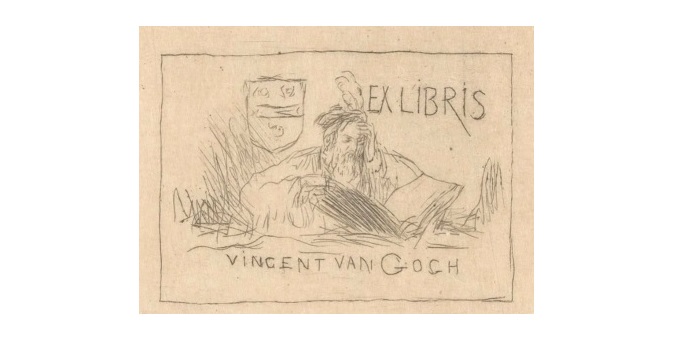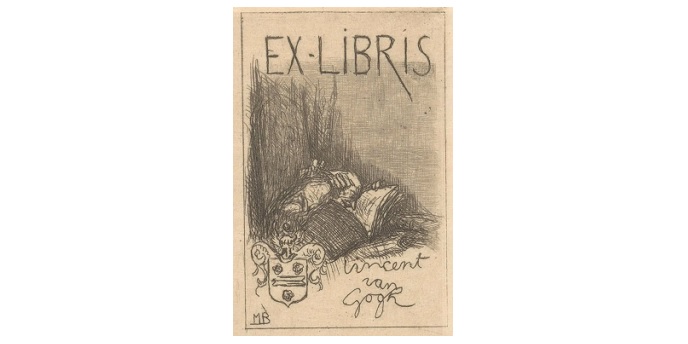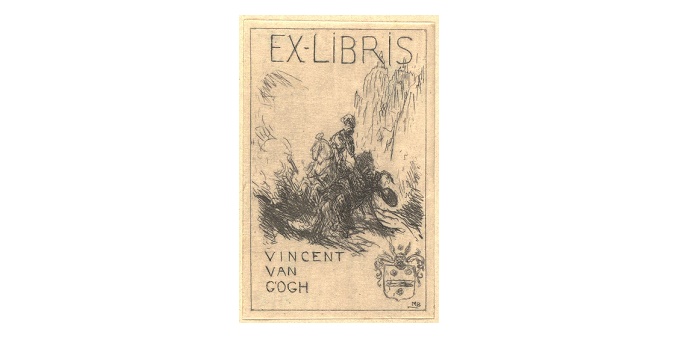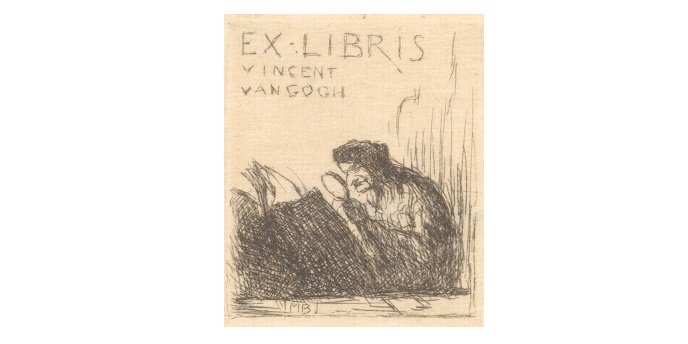An Emblem by Vincent van Gogh
In 1919, Mr Willem Geert Geertszoon Bakker donated his personal collection of emblem books to the University of Groningen Library. Emblems are a form of visual poetry that enjoyed popularity in Europe during the sixteenth and seventeenth centuries. The genre’s signature structure consisted of a picture (pictura), combined with a motto (inscriptio), and a longer subscript (subscriptio).[1] Bakker donated some seventy emblem books, with subscriptio ranging from epigrams to longer works of prose. This donation, which showcases the variety of the genre, has formed the basis for the University of Groningen’s collection of emblem books. This collection now encompasses over 200 unique books, and features work by famous authors such as Jacob Cats and P.C. Hooft.
One of the books in this collection has a particularly interesting history. The front endpaper of Antoine de Bourgogne’s emblem book De Ghebreken der Tonghe, en de middelen om die te verbeteren (The shortcomings of the tongue, and ways to overcome them) contains several markings. On the right Bakker’s bookplate and on the left an ex libris by Vincent van Gogh! The label in question is relatively small for an ex libris and the engraving features a man reading, as well as the Van Gogh family crest in the top left corner. Along the bottom the name Vincent van Gogh has been written. Could this book have belonged to the famous artist?
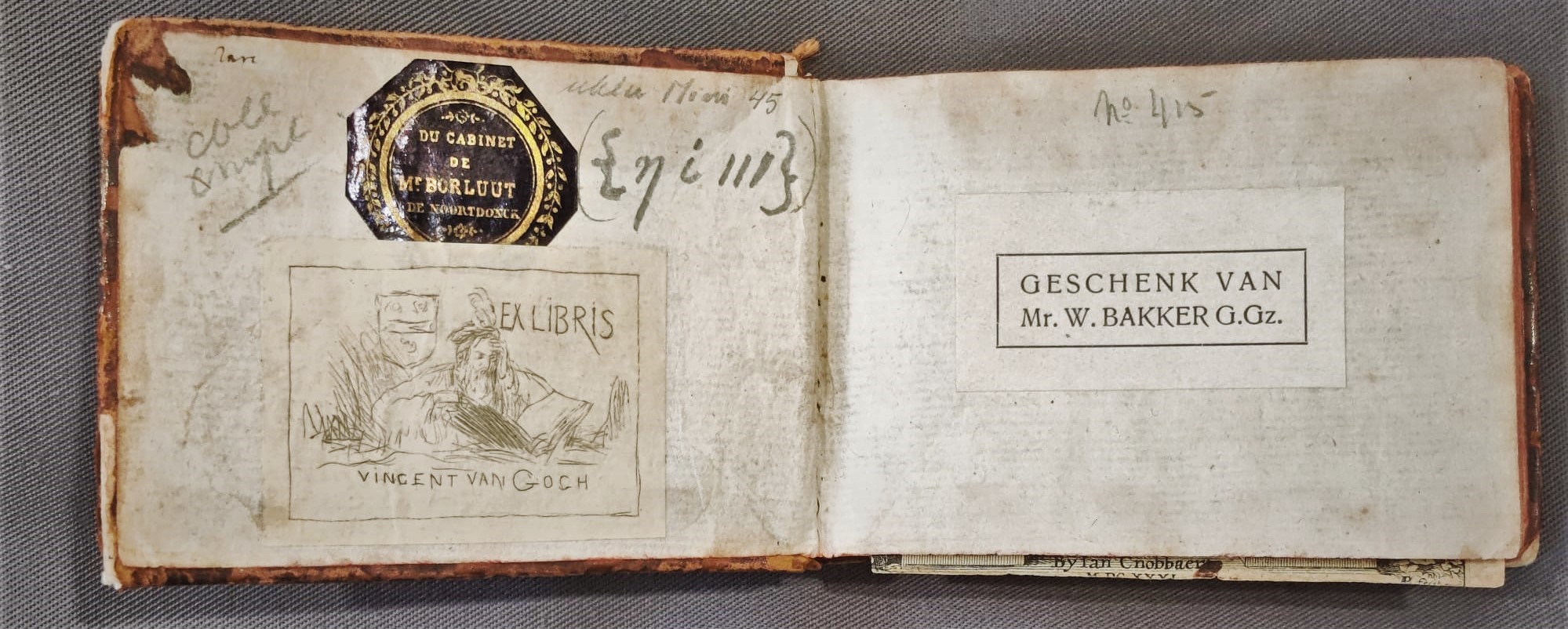
This book was originally printed by Jan Cnobbaert in Antwerp, 1631. At the time, emblem books were very popular. Authors used wordplay and unexpected imagery to connect the picture to the text. The purpose of these allusions differed, but emblem books were generally meant to be moralising and educational, and could be rather accusatory in tone. The author urged their readers to take a critical look at their own behaviour, and to measure it against the sinful or virtuous behaviour on display in the emblem book. The idea of self-reflection was often echoed in the titles of emblem books: Minne-spiegel ter deughden and Bespiegeling op ‘t leven der menschen are examples of this, as they contain the Dutch word for mirror. Bourgogne produced De Ghebreken der Tonghe in close collaboration with the printer Cnobbaert. To fine-tune the connection between images and text, authors and printers worked closely together. Each poem in this book starts off with a picture which, along with the motto and the subscript, shows a life lesson. It was up to the reader to combine the elements and draw their own conclusions as to the poem’s message.
However, this does not mean that Cnobbaert or Bourgogne designed these images themselves. During the seventeenth century, trade in pictura among publishers and printers in the low countries flourished. The production of emblem books was a very attractive commercial venture: their broad popularity meant there was a large group of potential customers. Therefore, it was not unusual to write (or commission) new epigrams to go along with existing images. This way, new emblem books could be produced quickly and cheaply.[2] Therefore, Cnobbaert may already have had a collection of images to choose from when he and Bourgogne were collating their emblem book.
After its publication in the seventeenth century, it would take more than 200 years for the book to fall into the possession of Vincent van Gogh. In the meantime, other owners left their marks. Beneath that of Van Gogh’s, an ex libris with the text ‘Du Cabinet de Mr. Borluut de Noortdonck’ can be found, indicating the book spent time in the possessions of the Borluut family. This noble Dutch-Belgian family had an extensive collection of books and bibliophiles knew François-Xavier Borluut’s collection to be among the most precious in Europe at the time. Around 1858, three successive auctions were held, and the majority of the Borluut-library was sold. Bibliophiles, book collectors and book sellers came from far and wide to attend the auctions, and it was the most expensive auction of books ever held in Belgium at that point in time. A surviving catalogue tells us that Bourgogne and Cnobbaert’s emblem book was sold during the first of the three auctions, on April 19th 1858. Could Vincent van Gogh have bought the book here?

Surely not, because the artist Vincent van Gogh was all but five years old and living in Zundert, Brabant with his parents at the time. This ex libris belongs to Vincent’s cousin, also named Vincent van Gogh (1866-1911). Many librarians have fallen for the trick, but the Van Gogh Museum in Amsterdam has confirmed that this particular ex libris was used by the famous artist’s cousin, not by the man himself.[3] Cousin Vincent was the son of Cornelis van Gogh (1824-1908), a publisher and art dealer in Amsterdam. Cornelis may have bought the emblem book from someone else, but it is also possible that he attended Borluut’s auction. He could’ve bought the book there and willed it to his son.
There are four surviving ex libris attributed to Cousin Vincent, all in the same sketched style. They were produced by Marius Bauer (1867-1932). Bauer was a painter by trade, but his graphic art was popular as well. In 1895 he was asked to contribute to the periodical Kroniek. This new publication was masterminded by P.L. Tak, a journalist from Amsterdam and Cornelis van Gogh was the magazine’s first publisher. The editors had approached Bauer to create cartoons for the magazine. Bauer and Cornelis were in close contact during their time working for Kroniek. The employees had a weekly meeting at Cornelis’ home to talk about the week’s cartoon.[4] Cousin Vincent must have known Bauer as an acquaintance and colleague of his father’s. Bauer was a year younger than Vincent, and must have left a good impression with his drawing skills. According to Cornelis, Bauer had ‘een goed oog voor de zotheid der dingen’ (a good eye for the ridiculousness of things).[5] It’s likely that Cousin Vincent asked Bauer to design him an ex libris, but as all of his ex libris are undated, it is impossible to tell when this would have happened.
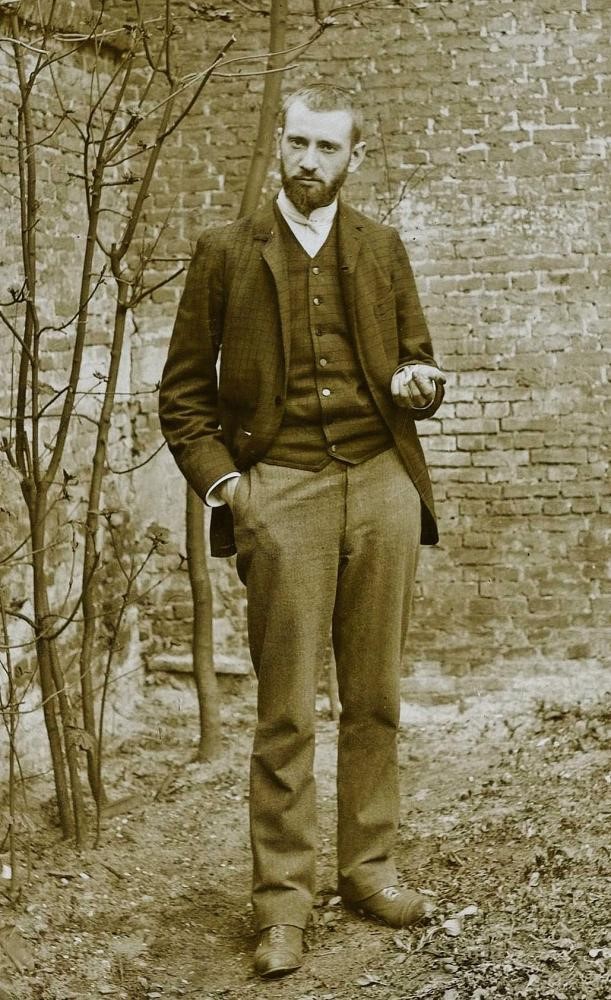
So, our copy of Bourgogne’s emblem book does not contain an ex libris of the famous artist Vincent van Gogh. However, it does reveal an interesting story about Cousin Vincent’s circle of friends and acquaintances. As the son of an art dealer and publisher, Cousin Vincent found himself among the culturally engaged citizens of Amsterdam, running into artists such as Bauer. As a result, we have been left a curious bit of art inside the cover of De Ghebreken der Tonghe, which gives us an insight into the life and times of this book.
[1] Charles Mosely, A Century of Emblems: An Introductory Anthology. Aldershot: Scolar, 1989, 1-16.
[2] John H. Landwehr, Emblem and Fable Books Printed in the Low Countries (1542-1813): A Bibliography. 3rd ed. Utrecht: HES, 1988, x-xi.
[3] Laura Aydelotte, "The Other Vincent Van Gogh.” Penn Libraries: University of Pennsylvania, Provenance Online Project, 2014.
[4] Henk Slechte, "Een zachtmoedig satiricus: De spotprenten van Marius Bauer in De Kroniek.” De Boekenwereld 19 (2002): 130–55.
[5] Henk Slechte, "Een zachtmoedig satiricus." 130.


